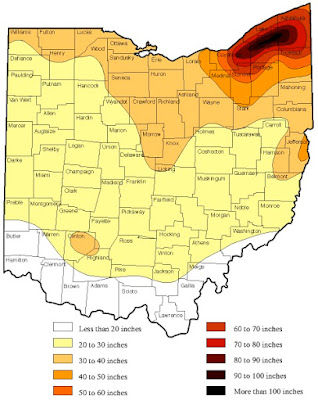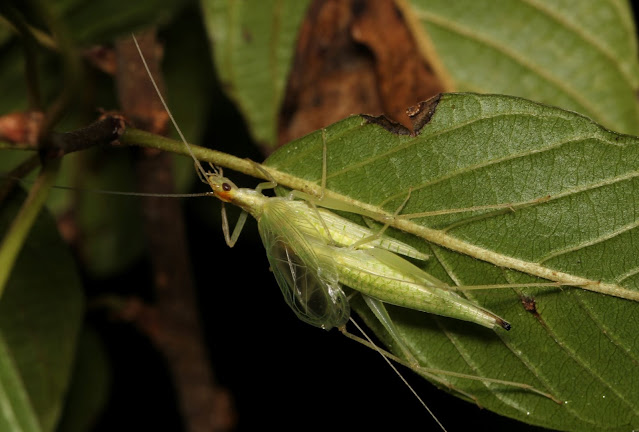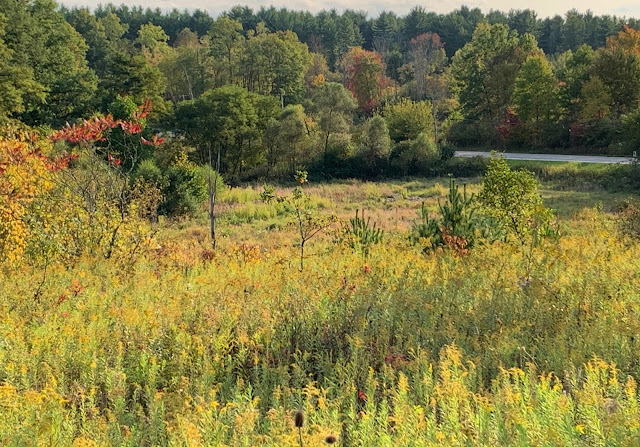I’m going to close my 2020 series of Listening in Nature posts with stories, photos, and recordings from my four-month field research project for the Geauga (County) Park District. Field research is typically immersive and richly rewarding for me. In this COVID year, my two places of safety and refuge were my home and the parks I studied.
This was the first year since 2012 that I’d spent my summer and fall studying singing insects for the Geauga Park District (GPD). I’ve surveyed crickets and katydids in all the counties in the extended Cleveland region of NE Ohio and created an online field guide for the seven-county area. But it was in Geauga County’s parks that I began my initial field study and research in 2008 and did multiple research projects between 2009 and 2012. Not surprisingly, the Geauga Park District feels like home. In a sense, it’s where I went to school when I was learning how to find, record, and identify singing insects.
For 2020, I created a research proposal that would document the species in each of four parks and park properties and how each location supported singing insect communities. I chose Holbrook Hollows in the southwest corner, Chickagami Park in the southeast corner, and both Observatory Park and an additional park property to represent the northeast.
In addition to four separate locations, I imagined weaving all that data into a larger four-movement work that would compare species prevalence and range expansion between the southwest, southeast, and northeast corners of the county.
It was an ambitious – and irresistibly fascinating - plan. I
would be looking and listening for possible answers to the following questions that intrigued me:
Which species are becoming established in Geauga County as they move northward into this region?
Do any parts of Geauga County still sound as they would have ten years ago because the northward species had not reached there yet?
Which properties have both Black-horned Tree Crickets and the look-alike Forbes’s Tree Crickets? I’ve been studying these two species for the past several years and Geauga is one of the NE Ohio counties in the species’ overlap zone.
I created this plan before COVID arrived in Ohio and submitted my proposal just a couple of weeks after all conservatory classroom teaching was moved online. Faculty and staff had just a few days to do what we could to prepare.
During the same time, virtually all of my upcoming naturalist teaching for the entire year was canceled.
But the grant was approved, and pandemic precautions would not limit my ability to pursue my field research
I was deeply anxious and worried about COVID, but also relieved that my survey would take me to the safety of the meadows, woods, and wetlands. I was primarily out after dark, as that’s when most crickets and katydids sing during the months of July and August. Because I was often in areas closed to the public or off trail, social distancing was not an issue. I always had a mask available should I encounter any humans. Travel was reasonable, as all of my research sites were within an hour of home.
The prelude to the singing insect season began in late May and early June. I expected Spring Field Crickets in scattered locations but did not know whether I’d find Spring Trigs anywhere in my Geauga survey sites.
During my 2012 survey in Frohring Meadows (southwest Geauga County) I remembered hearing one or two individual early-season mystery singers. I had no idea at the time who these crickets might be, as Spring Trigs simply weren’t even a consideration for NE Ohio. But Spring Trigs have been steadily, decisively moving north, so perhaps more pioneers were now entering Geauga County.
This is the NE Ohio snowbelt - the final frontier for southern and central Ohio cricket and katydid species that are moving north. (Map from Wikipedia)
When I initially checked Holbrook Hollows in mid-June, Spring Trigs were cheerfully singing in the warm afternoon sun! With each passing week, their numbers and locations increased. I ultimately found them at all four properties, though they were far more abundant at Holbrook Hollows in the southwest corner of Geauga.
The Roesel’s Katydid is a non-native, though non-invasive, species I generally find in the northeast corner of my northeast Ohio region. They were introduced from Europe to the Montreal area in 1952 and subsequently moved west from their initial introduction to the Chicago area and now into Wisconsin and eastern Iowa, according to Singing Insects of North America. Where did I find them this year? As expected, in the northeast corner of Geauga County.
The end of June and first week of July presented the first major proclamation of singing insect season’s arrival: Gladiator Meadow Katydids at the end of June...
and Broad-winged Bush Katydids a week later.
The most impressive numbers were at a GPD permit-only property in the northeast corner of the county. I have never heard or seen so many of these two species anywhere. (You can read more about these Gladiators and Broad-winged Bush Katydids in my July post, Worried...or Impatient?)
By the third week of July, it was obvious this would be an outstanding season for one of my favorite katydid species: the Oblong-winged Katydid. Though more common some years than others, they were ridiculously abundant in all corners of Geauga County in 2020
Late July and early August brought the annual explosion of tree cricket song in the meadows and woodland edges. Ground crickets and Fall Field Crickets were the continuo section providing the sonic foundation, and July’s katydids continued singing even as new sections of the insect ensemble joined them onstage.
I was immersed in sound and in moonlight, distant lightning, and even the aftermath of showers dripping from the leaves into the musical texture of my recordings.
Holbrook Hollows boardwalk, 8/2/20 (above). Curve-tailed Bush Katydids and Oblong-winged Katydids were singing, and this Curve-tailed pair was in the process of mating.
There was an obvious difference in insect song between the parks. Except for a few scattered Spring Trigs, I didn’t hear northbound crickets and katydids in the northeast corner of the county. When I would arrive at Observatory Park and the other nearby GPD property, the ensemble sounded so familiar.
It was the sound of 2010 rather than 2020.
Two Narrow-winged Tree Crickets mating while a third sings hopefully right above them. NE Geauga County. The recording below is his picture.
There were no Handsome Trigs, no Jumping Bush Crickets, no Round-tipped Coneheads…were they going to mature late up there, or had they yet to arrive at all?
August is always the most joyful month of my year. All the remaining crickets and katydids mature within that month until the full insect ensemble performs its orchestral tutti. Later August also brings glorious beauty to the meadows: goldenrods, asters, Joe-pye weed, ironweed, and various tall, yellow composites whose names I have yet to keep straight.
I still had several weeks remaining for the survey.
I tried to keep remote teaching, increasing COVID anxiety, and my fieldwork as separate as I could. At times, I succeeded in focusing on how fortunate I was to teach safely from home and also do research safely distanced in the field. But I couldn’t keep up with the work and still edit or even label my photos and field recordings.
Academic calendars do not wait, nor does Nature.
In the southern part of the county, Jumping Bush Crickets and Handsome Trigs were abundant throughout Holbrook Hollows. What a contrast to the first little cluster of Handsome Trigs that began to colonize nearby Frohring Meadows just over ten years earlier!
Female Handsome Trig, Frohring Meadows, SW Geauga County, 2012
I’d only found Jumping Bush Crickets in one location on the border of Frohring in 2012, but now they were a significant part of the August and September ensembles both at Frohring and at Holbrook Hollows.
Round-tipped Coneheads had already rapidly established their presence at Frohring even in 2012 and their penetrating buzzing was mixed into the sound texture of Holbrook Hollows as well.
Handsome Trigs, Jumping Bush Cricket, and Round-tipped Conehead at Holbrook Hollows
Southwest Geauga County’s parks sounded like Portage and Summit Counties to their south
While in lesser numbers at Chickagami in southeast Geauga, these species were not part of the soundscape in the northeast at all. Their songs were more common even along the lake shore in Lake County than inland. Lake Erie's waters keep those areas warmer in the late fall, so singing insect may have more time to complete their life cycle.
The northeast Geauga snowbelt still sounded like…the snowbelt.
Only later in the fall did I hear a few pockets of Handsome Trigs and a couple of Jumping Bush Crickets and Round-tipped Coneheads. Driving from Holbrook Hollows to Observatory Park sounded as if I’d gone back ten years in time.
Time was short now, as nights were getting too cold for insect song. I still needed to record the crickets whose species I could only determine by analysis of their songs: the Forbes’s Tree Crickets and if present, the look-alike Black-horned Tree Crickets. I’d recorded about 30 of them at Observatory Park the previous year and now hoped for a reasonable sampling from Holbrook Hollows. Wetland restoration work was already beginning at the park property near Observatory, but maybe I could still manage to make some recordings there as well.
He was singing at Holbrook Hollows, but was he a Forbes's Tree Cricket,, or a Black-horned Tree Cricket? It's not possible to tell without a song analysis by temperature and wing strokes per second.Field recordings from Holbrook necessitated bushwhacking
through very dense, tall goldenrod mixed with blackberry, scattered saplings,
and shrubs such as red osier dogwood on a slope dropping down toward a wetland. My
additional Holbrook site was in a power line corridor that also featured blackberry
and tall goldenrod.
I managed to safely negotiate both locations and even brought home two crickets I thought sounded a little different from each other. In addition, I also brought home two more crickets from the northeast Geauga property– a quick catch before rain threatened to drench my recording equipment.
Once I could record and analyze their songs from home, I confirmed that I had a Forbes’s and a Black-horned Tree Cricket from each of those two sites. Both species are definitely present in northeast and southwest Geauga County.
A cold spell in September greatly diminished singing insect numbers a little earlier than I would have expected, and by early October I had to acknowledge that the survey was essentially over.
As I do every year, I spent the next month close to Lake Erie’s relatively warm waters that delay a singing insect-killing freeze near the lakeshore. It was the annual postlude that concluded with just the singing insects I had been able to catch and bring home to finish their final performances next to the south windows of the dining room by day and near the heat vents at night. I listened to them every afternoon and evening as I graded assignments and prepared exams.
Finally in late November and December I could edit the photos and field recordings that documented not only the singing insects but everything I’d seen, heard, and absorbed in those four months. As in previous years, I came to love the places I studied in such detail and so deeply appreciated what they revealed, shared, and taught me. This year, they also kept me safe, emotionally nourished, and grounded as only nature can.
In addition, I'll be doing a presentation on my 2020
research for the Geauga Park District that will be free and open to the public
(probably via Zoom), and I’ll announce the date once it’s been scheduled. It should also appear on the GPD website under "Programs and Events."
If COVID-19 permits, I also expect to co-lead a singing insect hike at one of the survey sites in August.
You can reach me by email at lisa.rainsong@listeninginnature.com



























Taking a trip with you, even when only virtual, is a soul soothing experience. Also educational. Now, in January, you have me longing for the smells of late summer. Don Harvey
ReplyDeleteTaking a field trip with you, even when virtual, is always an educational and soul soothing experience. Now, in January, you have me nostalgic for the warm smells and sounds of late summer. Thank you. Don Harvey
ReplyDelete